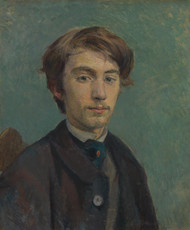Émile Henri Bernard (28 April 1868 – 16 April 1941)
Published by Therese Myles on 8th Nov 2019
Born in 1868 in France, Emile Bernard is credited with Cloisonnism, a style simplified decorative art that used thick black lines to enclose flat areas with vivid and bold colors, while in Pont-Aven. Additionally, he worked alongside Paul Gauguin to produce a style known as Synthetism, a style that synthesizes the form of a painting with the feeling or theme of the subject. He studied at Ecole des Arts Decoratifs, but was suspended as the result of “showing expressive tendencies in his paintings”. He also joined Fernand Cormon’s studio where he became friends with Vincent van Gogh, Eugene Boch, Gauguin, and Cezenne.
Over time, he traveled and settled in Egypt, where he focused his career on writing, as well as studying philosophy and religious mysticism. He also became interested in tapestry art, wood carving, and Japanese woodcuts.
Most of Bernard’s most famous works were created early in his career and include La Grandmere (1887), “Breton Women in a Green Pasture” (1888), and Buckwheat Harvesters at Pont Aven (1888). He is considered a significant contributor in the field of modern art He died in 1941 while living in Egypt.

